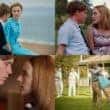Costume designer Keith Madden discusses working with the script and the actors to design the costumes for On Chesil Beach, his collaboration with production designer Suzie Davis, and how the clothing of the characters can help make period-specific concerns more palatable to modern audiences. This is the fifth article in our Special Issue on On Chesil Beach.
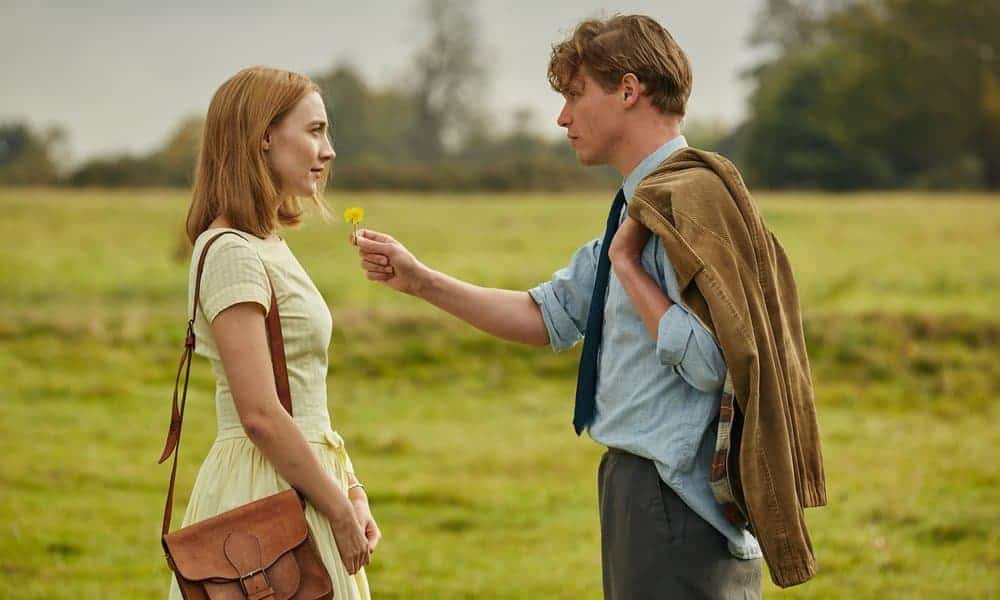
Keith Madden’s costume designs in On Chesil Beach, a period film set largely in the ‘60s, tell us so much about the expectations of class, tradition, gender, and sexuality under which newly married couple Florence (Saoirse Ronan) and Edward (Billy Howle) live. For Madden, a pretty dress is not there simply to look pretty; it’s a window into the self-expression of our protagonist.
I spoke to Madden about what went into designing the centrepiece garment of the whole film (Florence’s blue dress) how his work as a costume designer is similar to acting, and why he avoided completely anchoring the film in its period to achieve a sense of timelessness.
Listen to our podcast on On Chesil Beach and Normal People
Seventh Row (7R): What initial ideas did you have for the costumes in On Chesil Beach after reading the script and talking to director Dominic Cooke?
Keith Madden: First of all, I thought about Florence’s character: her background, where she came from, and her situation as opposed to Edward’s. I always saw Florence as this person who didn’t want to draw attention to herself because of what’s happened in her past with her father. Her love of music always came first, and what she wore, although pretty and of the time, came second. Everything about her was all very quiet. I wanted to keep Florence very quiet at first. Gentle, pretty, but without bold colours or bold patterns.
Then, going into the honeymoon dress — that dress and that colour and her situation became very different. She was more confident, more grown up, so I wanted something that was extremely dynamic. Similarly, by this point, Edward is a very dark, strong suited character [on their wedding night], whereas before he was kind of messy — he basically wore the same jacket and same tie all the time. I wanted to give them strength in that moment.
There, both these people have reached a point where they’ve gone through the education system and they’re ready to fly and leave home. They were going to continue their lives happily together, away from the restraints of each of their parents, who were in one way or another quite dysfunctional. Ultimately, it’s their inability to talk to their parents about what sex was going to be like when you were married that leads to their breakup.
Florence’s blue dress also helped with the flashbacks: we would know straight away that we’re back in the present, in the hotel, because the colour was very recognisable to the present.
We filmed in October on Chesil Beach, which was quite grim. The skies were grey, the sea was grey and I thought to myself, “If nature isn’t going to give us blue, then we’ll add that blue to the dress.”
We wanted the room to be quite oppressive. With the bed being red, it’s the scene of the crime, really. Florence has to go to bed with Edward to consummate the marriage, so it’s there looming all the time. I wanted the blue to jar with the red, to show that Florence didn’t have a place in that room. It became uncomfortable; the colours weren’t going together. Her place was on that beach, feeling free.
7R: She’s always looking out the window to the sea.
Keith Madden: Always looking out into the blue, yes. So it almost couldn’t be any other colour. It was sea, sky, freeness, wind, all of that.
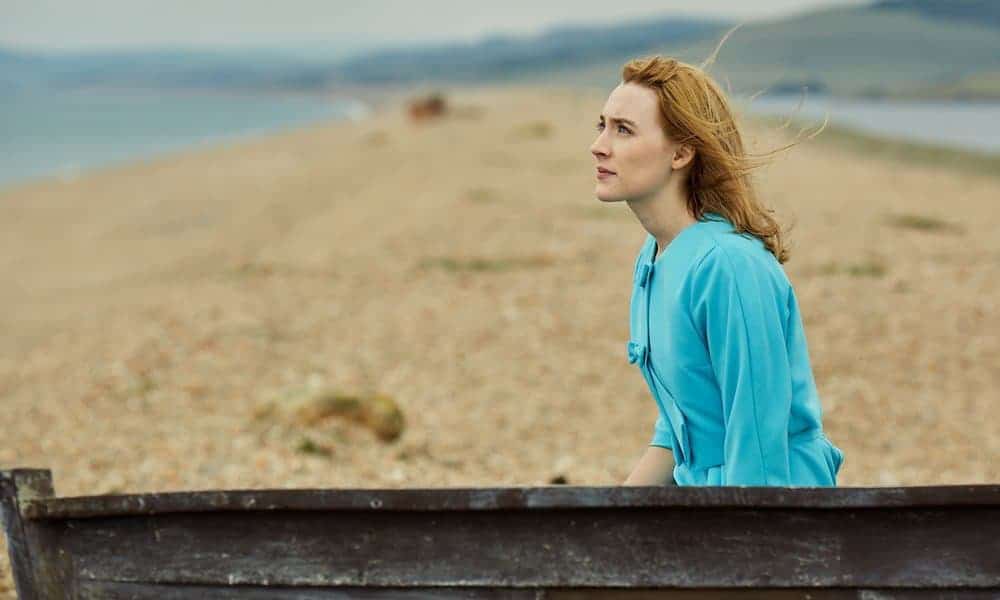
7R: In the flashbacks, the colours she wears aren’t as bold. There are a lot of yellows.
Keith Madden: She wears a lot of yellow, some pink, white… these very natural colours that don’t make too much of a statement. It was only [on the wedding night] that I put her in a colour as strong as that blue.
7R: You talked about the dress standing in contrast to the reds in the hotel room. Did you worked closely with production designer Suzie Davies to create that colour scheme?
Keith Madden: I worked very closely with the production designer because we wanted to bring a cohesion to the shots. We would talk about specific colours that we would be choosing, and then we would place some of those colours within the set. It brought everything together.
I always find that filmmaking is like painting with lots of different hands, but it’s got to be one film, one tone. So there’s got to be a lot of dialogue, a lot of exchanging emails, a lot of sitting down talking.
In the creative meetings that Suzie and I had, we talked about various things, put our heads together. It was discussed that we would make the whole thing as tight as possible colour-wise. A lot of it [ended up being] coincidental. It got to a stage when we were working so closely together that it just worked.
7R: Dominic told us that he had shooting rules for each location for On Chesil Beach: Edward’s house was shot with steadicam, and Florence’s house was shot locked down and symmetrical. So did you have rules for the costumes in different environments? Did you think about when you wanted them to blend in or stand out from their surroundings?
Keith Madden: I didn’t specifically want Florence to stand out in the moments set in the past, because I thought the blue dress was such a turning point for her. Because of what had happened in the past, she wasn’t the sort of girl to try to draw attention to herself in any way. When she was playing the violin, she then suddenly had a strength, so sometimes I would put her in trousers.

Also, practically, we decided that it would make sense for her to have a pair of trousers, so she could be more comfortable playing the violin. The ladies in Florence’s ensemble were actual violinists, so we asked them about what they should wear, and there wasn’t a lot of jewellery because it would get in the way. Florence wore a gold watch which she would take off before she played, so it was only her and the violin.
7R: Her clothes for playing the violin aren’t patterned. They’re all block colours.
Keith Madden: I wanted to make her very practical as a person, she was never this flowery, frivolous individual with a light heart. There was always something very intelligent about her. That beautiful pink and grey dress she wore in the boating scene was the most pattern that I ever really wanted to introduce for her.
[click_to_tweet tweet=”‘I always find that filmmaking is like painting with lots of different hands, but it’s got to be one film, one tone.'” quote=”‘I always find that filmmaking is like painting with lots of different hands, but it’s got to be one film, one tone.'”]
The period’s just coming out of the ‘50s and into the ‘60s. You’re very much led by your parents. There was no teenage revolution, so that’s why they couldn’t talk about stuff. They had no mates to talk to. They were misinformed by various people. They couldn’t talk to their parents. You couldn’t experiment with clothing the way people do today. You were a young girl, and then suddenly you turned into your mother.
7R: You’re right that she’s not a frivolous character, so I think it’s interesting that there’s bows on her shoes and her jacket on her wedding night.
Keith Madden: The outfit was so simple that even the addition of two bows made it very special to her. That’s her bit of frivolity. That’s her little bit of celebration that she’s getting married, but it’s a very, very small detail.
7R: Florence and Edward are caught between two worlds: the film is about this back and forth between a more traditional mindset and an emerging modern way of thinking. And then there’s the class difference between the two of them.
Keith Madden: Florence was quite clean, clear, and modern, and Edward was almost stuck in the past. He wasn’t allowed to move forward — like how Edward’s brain-damaged mother was stuck in the past. She wasn’t allowed to move forward because of her accident. Edward was very much in hand-me-downs. He basically just picked stuff off the washing and popped it on. He had a favourite jacket, always wore a tie.
[click_to_tweet tweet=”‘You couldn’t experiment with clothing the way people do today. You were a young girl, and then suddenly you turned into your mother.'” quote=”‘You couldn’t experiment with clothing the way people do today. You were a young girl, and then suddenly you turned into your mother.'”]
It was about trying to make those comparisons and differences appear on screen. Edward’s clothing is very textural, wooly, and he had an element of scruffiness to him. He had always untucked the back of his shirt.
7R: I think it’s interesting that the film is using the trappings of a typical period piece but seeing that through a modern lens.
Keith Madden: Yes, completely. Everything’s period correct, but by taking away patterns, it becomes more about silhouettes. You’re able to present it in a more modern interpretation. You could present it without it being stiflingly ‘60s. It gives it a new relevance, a clearer message. With Suzie and myself, I hope we managed to get that message across. Sometimes you look at it and it felt so modern in its look.
[click_to_tweet tweet=”‘The outfit was so simple that even the addition of two bows made it very special to her. That’s her bit of frivolity.'” quote=”‘The outfit was so simple that even the addition of two bows made it very special to her. That’s her bit of frivolity.'”]
The film has real relevance today, I think. For how many friends we have on Facebook, we still only talk to very few people about feelings and about sex and how to cope with those initial fumblings. We still haven’t really moved on from that. We’ve a lot to kind of gain from looking at this film and thinking about the issues that it presents. A lot of thought went into this film, particularly. It’s something that we all wanted to get right because it has such a delicate message.
7R: I think the blue dress is quite timeless. It’s very simple, just one block colour.
Keith Madden: That dress is basically the heart of the film. You see it in one garment. There was so much umm-ing and ah-ing, the backwards and forwards in your head about whether it’s the right colour, the right fabric, the right shade. Does it fit well? Are we doing the right thing? In the end, you just have to say, “No, this is what I first wanted. This is it.” You just know that it’s worked. I felt that it did everything that I wanted it to do.
7R: So what we see in the dress costume in On Chesil Beach is quite similar to your original idea for that dress?
Keith Madden: Yes. When I read the script, I then quickly regurgitate all that on to a mood board. The initial read of the script is your first intake of the film. As I’m quite a visual person, all these visual things would come out as I’m reading the script. An hour afterwards, you’re then just pulling images, whatever images they are, and you put it down on paper. It’s so rare that I deviate from those initial mood boards. I go back to them time and time and time again, and that keeps it all tight for me.
7R: What did your mood boards look like for the costumes in On Chesil Beach?
Keith Madden: I do two main ones: one for the film, and then I go into character. Mainly, the images are about Florence’s and Edward’s clothes; others were not even costume-based, but just images that could keep me focused on that person’s character, or their background, or where they lived. It was not just about the dress. It was about what they ate, what they saw walking down the street, the people they would have met.
[click_to_tweet tweet=”‘Everything’s period correct, but by taking away patterns, it becomes more about silhouettes. You’re able to present it in a more modern interpretation.'” quote=”‘Everything’s period correct, but by taking away patterns, it becomes more about silhouettes. You’re able to present it in a more modern interpretation.'”]
In the book, it was very much that Florence went to university, stayed in a dormitory full of girls. They were all probably violin players, a little bit prim.
7R: Would you equate your process as a costume designer to acting?
Keith Madden: Definitely. You very much have to have an understanding of the character. Some of the male characters that I get in various different films, I end up having taken elements of the costuming as part of my own wardrobe. Your mind is full of what you’re doing in that film, so you do start to become the film, on a costume level. If that person sometimes wears a neckerchief, the neckerchief goes on me.
7R: Dominic said that he was modelling On Chesil Beach after the look of early ‘60s films. Were there any particular visual references in cinema that you looked at for the costumes?
Keith Madden: One for me was Susannah York. She did a film in that period of the early ‘60s, and I love the colours that she was wearing and the shapes of the dresses. There were things like A Taste of Honey, which we all discussed. And Albert Finney.

Another film that I looked at was Woman in a Dressing Gown, an old black and white film. It was based on this woman who’s going slightly mad. She can’t function anymore. She always wears this dressing gown and her husband is always working, so that gave me some lead to the characters of the Mayhews.
7R: You’ve done a lot of period pieces. What’s your general approach to researching a certain period to design the costumes?
Keith Madden: My research is my key. I always say, ‘Research, research, research’. Once you’ve made rules for that particular period, you can break them. But you can’t break them if you don’t know the rules inside and out. You can’t start playing with the period unless you know what has gone on in that particular time, what people are wearing, and why.
[click_to_tweet tweet=”‘When I read the script, I then quickly regurgitate all that on to a mood board.'” quote=”‘When I read the script, I then quickly regurgitate all that on to a mood board.'”]
I love period. I like history. I’m nosey. I want to know why. I take inspiration from different characters in life. You go to research at the V&A. I went to some very interesting exhibitions in Compton Verney: they were doing this amazing 1950s exhibition of clothes, and one of the dresses there I took photographs of and then recreated it. You go and do the legwork, and then you get more of an understanding of the era that you’re trying to create through costume.
Some of the pieces that you put on can look very strange to modern eyes, like Saoirse’s jacket on the dress. It’s a very odd shape, where the darts are, where everything is… but it’s those kind of oddities that make a period.
7R: I’d imagine it was more difficult to get into the characters’ heads in On Chesil Beach to design the costumes because the film takes place over so many decades. How did you chart their progression between 1962 and 2007?
Keith Madden: As a person, you reach a peak in your fashion knowledge or what you feel comfortable in. You’re very comfortable in a happier time in your life. I felt that Edward, after we left him, didn’t really deviate from what he was wearing as a young boy: tweed jacket, tie… I wanted to make clear that this time with Florence had been his happy time. When he comes back, what he’s wearing very similar to what he was wearing in the past.
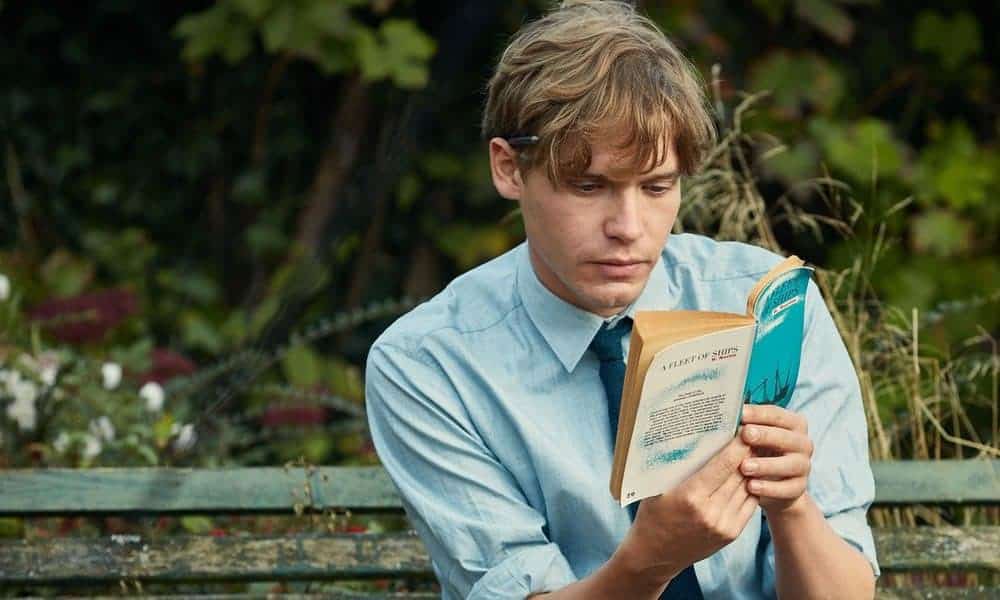
There’s a fine line between knowing exactly where we are period-wise and pushing the period too far, which is never something that you want. I hate when people really over-compensate for a period. It becomes cliché.
7R: Did the rehearsal process, where the actors are developing their characters, have any affect on your designs?
Keith Madden: Normally, with period, I get the actors in as soon as possible. Sometimes, it all works beautifully. I’ll get an actress in: I found a dress; the dress is great; it fits beautifully — but it’s the wrong colour. So you explore around, looking for the right stuff to turn this dress you’ve got into the dress that you need.
Sometimes, when you’re working with actors and actresses, their availability is not great because they’re busy doing other projects. You have to get as much information as possible in the shortest time.
[click_to_tweet tweet=”‘You can’t start playing with the period unless you know what has gone on in that particular time, what people are wearing, and why.'” quote=”‘You can’t start playing with the period unless you know what has gone on in that particular time, what people are wearing, and why.'”]
We have a good chat so that we’re both on the same page. We sit down and talk about the character and what they’ve been through. So by that point, we both have this understanding: the actor has an understanding of my understanding and I have an understanding of their understanding. When we start trying clothes on, we both feel very comfortable that we’re saying the right things. That eases both of our minds.
Once you’ve found a key garment, it all starts sprouting out from there. You could find a coat or a dress or a blouse or a pair of trousers or anything, and that informs the next stage, the next outfit. That’s a key point in the process. It evolves from there.
I was discussing Emily Watson’s clothes with her, and I had a particular garment hanging up. She pointed at it, and she said, “I love that. It’s very spiteful. It has very spiteful colours.” We tried it on, and it was great. It was a wonderful moment, for a costume designer and for an actor, to start discovering who that character is. Once you’ve got those clothes on, they make you behave in a certain way. That helps. It helps them to discover what that character is all about, and it makes them stand differently, look differently.
In our interview with Billy Howle, he told us how his costumes helped him get into character for On Chesil Beach.
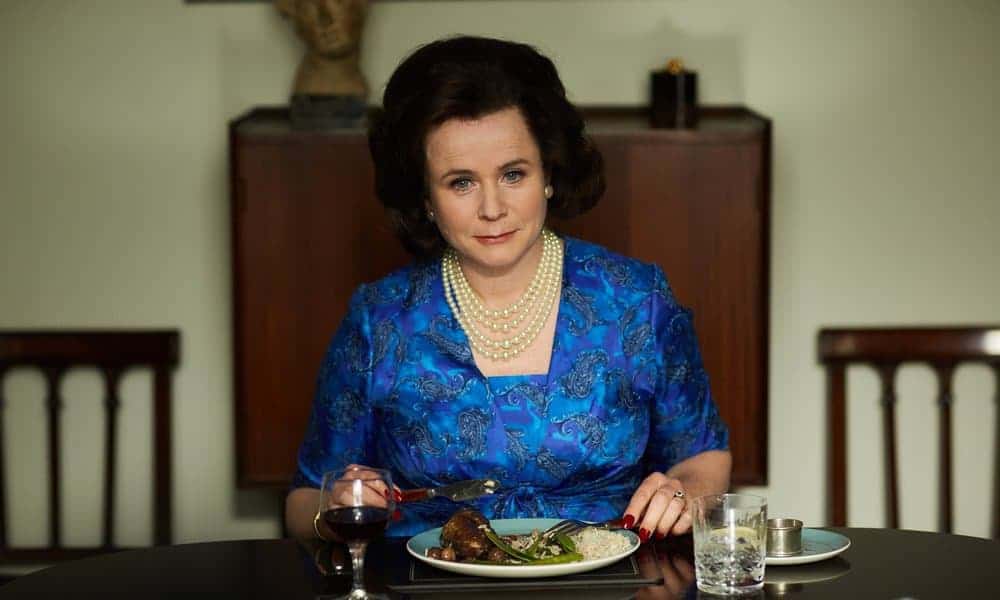
7R: The bulk of the film is framed around one extended, excruciatingly awkward sex scene, and there’s a lot of complex choreography regarding how they undress. How did that affect the mechanics of how you designed their wedding night outfits?
Keith Madden: There was a certain sexuality about the whole thing, so the fabric that was chosen for the dress is a bit flowy, a bit sensual — the way it rides at the thigh, and with the stockings. I wanted to create a dress that would push up the sides easily. It wouldn’t give much resistance.
Then there were the mechanics of Edward trying to get the zip undone, so we knew there had to be a zip at the back. So there were elements that we had to have there to make the scene work.
[click_to_tweet tweet=”‘Once you’ve found a key garment, it all starts sprouting out from there.'” quote=”‘Once you’ve found a key garment, it all starts sprouting out from there.'”]
But also, the dress had much more of a modern silhouette. In the ‘50s, the skirts and the petticoats were coming out, and in the ‘60s they started to go in and up, resulting in the shift dress in the mid to late 60s. Her dress was very much in the vein of going in and coming up, so it had no petticoat. It was bang on the knee, or just below the knee.
7R: When do you, if ever, stray from the realism of the period?
Keith Madden: I’m always very aware of not treating the viewer as though they don’t know anything at all about costume, because they do. They know more than they think. They know, when watching a film, if something isn’t right. They won’t know why, but they will know. Research is really important to get a feel of each period that you’re doing. I treat people with the intelligence of knowing as much as I do. If they start asking questions about my costumes, then I feel as though I’ve failed. We’re not asking questions about my costumes; we’re asking questions about the film and the story that’s being told.
Read the rest of our Special Issue on On Chesil Beach here >>

